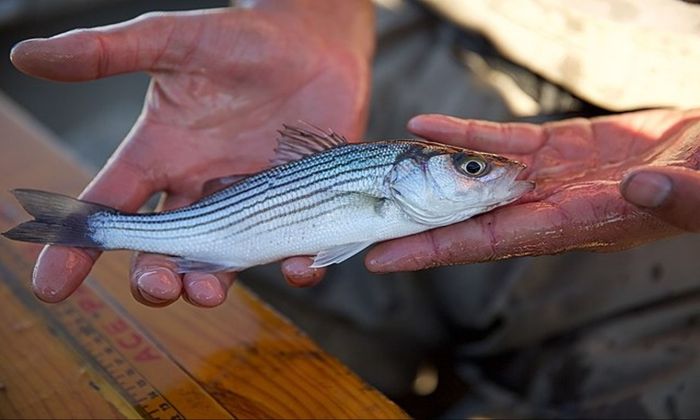How To Spot and Catch the Elusive Striped Bass
Here are some striped bass fishing techniques for anglers eager to catch this elusive but fascinating fish species.
The striped bass is a well-liked game fish among commercial and recreational anglers. It is also known as the Atlantic striped bass, striper, line-sider, or rockfish. It has seven to eight stripes down the sides of its body, as the name would imply, and can range in color from light green and olive to brown and black. It is easily distinguished from other species thanks to its glistening white belly, plump bodies reaching 70 pounds in weight, and lengths of up to 5 feet. Although this fish spends most of its adult life in saltwater, it is anadromous when it spawns and has even been shown to thrive in freshwater environments.
Striped bass reproduce in freshwater, and many are forced to live in landlocked conditions due to dams and other man-made barriers. However, as was already said, they are adaptable and may thrive in a freshwater environment. It is widely known as an elusive species, but plenty of creative ways exist to catch it.
Keep in mind that depending on what the fish are eating on, the weather, the tides, and the temperature, what works one day may not work the next. Here are some striped bass fishing techniques for anglers eager to catch this elusive but fascinating fish species.

Know Where to Find Them

Knowing where to find striper fish is essential because stripers tend to gather in particular areas during particular seasons. Striper anglers and women focus their efforts on streams, estuaries, bays, and tidal rivers in the early spring. Bass swim in schools north as the spring striped bass migration proceeds, creating a window for surf and beach fishing. Because of the reduced oxygen levels in the bays, rivers, and estuaries throughout the summer due to the rise in water temperature, stripers prefer the colder waters of New England.
Rarely do striped bass appear farther than a few miles inland. Stripers are typically caught by anglers near river mouths, in tiny, shallow bays and estuaries, along rocky shorelines, and sandy beaches. The striped bass is a schooling species that first travels in small groups before dispersing into big groups for migration and eating.
If anyone knows the best places like the back of their hands, it’s the experienced guides like 289 Striper Guide, which specializes in striped bass fishing.
Nighttime is the Best Time to Catch Stripers
After sunset, large stripers go into shallow water, providing shore and surf angler a chance to catch large bass. Although lure retrieve rates are often slower, it's crucial to experiment to determine the fish's preferences. It's essential to bring many flashlights so you can see what you're doing.
Fishing at night could get pretty scary, so it’s best to be accompanied by experienced guides like Andrew Tubbs Fishing Charter.
Best Bait and Lures to Use
Because it is what they eat, live bait is a well-liked and effective way to catch striped bass. Stripers are opportunistic feeders, which means that, depending on what is available locally, they will consume a variety of baitfish, shellfish, and other marine organisms.

By affixing an artificial bait to the end of your fishing line, you can also successfully trick stripers. The shape, motion, color, and vibration of natural bait are all mimicked in the creation of lures. Some of the newest lures have fragrances integrated right into them to persuade fish to strike the bait.
Jigs, stick-baits, and diving plugs may all be successful, but remember that nighttime is typically when dark colors perform best. The colors of choice are black, dark red, and purple. Keep a watch on your lights as you cast your lures because the bait will soon start to show up.
Have McCraw’s Guide Service help you choose the best and most appropriate baits and lures when catching the elusive striped bass.
Experiment With Different Techniques
One of the finest methods for catching a lot of good bass is to troll a striper rig behind a boat or kayak. A boater or kayaker can cover a vast area quickly and catch numerous fish at once while trolling for striped bass.
Even for seasoned anglers and ladies, striper fishing from a kayak is thrilling. Because of their size and mobility, kayakers have an advantage because they can access locations that are typically inaccessible to shore and boat anglers. You can fish while paddling a kayak, or you can fish while pedaling.
Unlike tuna, mahi-mahi, and other offshore fish, stripers can be caught from shore, making them unique. The four most common techniques for catching stripers while surf fishing are lures, flies, surf rigs, and live bait. Waders help surf anglers, and women access deeper water while keeping them dry and enabling them to make lengthy casts as needed. Even while you may make long-distance casts with the newest surf fishing equipment, stripers frequently stay close to the beaches in the troughs and wash where tourists gather in the summer.
Stripers aggressively look for food at sandbars, troughs, holes, points, and cuts in the surf. These places stand out due to a shift in the bottom's contour, which creates an ideal feeding environment along with the current change and turbulence. It is well worth the effort to locate these locations during low tide.
Fishing the waters of San Francisco for striped bass is best done with seasoned guides, and Curt Goff Striper Guide is perfect for the job.




